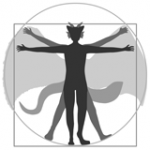Project Lead – Develop a kinetic model of digitigrade stance
- 3-5 hours per week for research duties
- 1-2 hours per week for communication, correspondence, or meetings
- Volunteering remotely / online
At the Freedom of Form Foundation, we believe that everyone should have the right to biologically express their identities, living life in the body that feels most natural to them. Today’s advances in biotechnology and medicine present a once-in-a-lifetime opportunity to develop the tools required to allow biological self-determination in the near future. Tails are on the horizon, potentially sooner than you think!
Engineering body alterations requires answering many research questions. We are looking for someone who will solve one of the most fundamental biomechanical challenges we face – developing a general, basic model of the forces and kinetics of the bones and joints in digitigrade hindlimbs, at rest and in motion. Ultimately, the model you develop will help determine optimal bone lengths, muscle strengths, and joint angles for digitigrade legs, and will even influence how we approach tissue-specific questions such as bone density and muscle pennation angle.
General project goals:
- List important physical elements, such as bones, joints, tendons, and muscles. Chances are this would just be the ankle to get started – but you might find more parts make for a more informative model!
- You might develop your model in any suitable software – anything from Python or R to OpenSIM, or anything else, is fair game. (Integrating your model into our systems once you’ve developed it is the easy part!)
- Develop a two-dimensional digitigrade stance model at rest, with constant forces and strain.
- Develop a two-dimensional model in motion, i.e. a walk cycle, with variable forces and strains.
- Use the model to explore peak forces that might occur in running or jumping.
- As a stretch goal, develop a three-dimensional model, that might include forces needed to stabilize the ankle against out-of-plane motion, and similar complexities.
- Analyze how changes in properties, such as lengths of bones and joint angles, impact the system.
Responsibilities:
- You will be taking on a highly independent role, and will be reporting directly to our Chief Technology Officer (CTO), Lathreas. (They are extremely friendly and supportive, don’t worry about that! They are brilliant and will genuinely be a great resource for you).
- Two-way communication with our CTO, other researchers, and other volunteers.
- Being resourceful and creative to find information and resources you need.
- Developing a more detailed project plan, listing tasks and deliverables, and following through on it.
- Occasionally sharing your research with our community through presentations, newsletter articles, and other contributions. (This is seriously a lot of fun, and helps us get more resources to help your project! Don’t sweat it.)
Qualifications:
The four most important questions we would ask you are:
- Does our mission mean something special to you?
- Do you feel personal accountability for projects and tasks you are involved in?
- Do you enjoy learning new things, and applying your abilities in new ways?
- Are you willing to see a project through to the end, within the bounds of your personal health?
Positive answers to those questions are the biggest predictors of success – more important than professional degrees, in our experience. If you can answer yes to all four questions, we strongly encourage you to reach out, even if you don’t feel that the technical qualifications below are a fit. There’s a good chance we can find something that works.
Now, in more technical terms, we are generally hoping for someone with:
- A strong foundation in modeling kinetics or classical mechanics. Having obtained a degree related to classical mechanics, being close to graduating, or having practical experience with physical modeling, is recommended for this project.
- Some programming or coding experience in at least one language.
- The ability to gather, analyze, and summarize complex and sometimes conflicting information.
- Experience working on a complex project independently, and delivering results successfully.
- Exposure to situations requiring interdisciplinary collaboration or communication.
- The ability to act as a generalist, and willingness to go outside your main area of training.
The above qualifications are intentionally broad. We believe in translatable skills, and no matter what, you’ll need to think creatively to solve new problems.
What you can expect:
- Supportive and genuine environment, and source of new friendships.
- Access to tools and resources. If you need something for your project, we’ll cover it.
- Stretching yourself with new challenges in a growing environment, practicing new career skills earlier than your contemporaries.
- Seeing your work make an impact, and create something you’re proud of.
Questions?
If you have any questions or want to discuss more before applying, please send an email to [email protected]. We won’t bite (too hard)!
In particular, if you are interested in this or other volunteering opportunities, and you’re not sure whether or not it would be a fit, please reach out and we’d be happy to explore possibilities with you.
Sounds good? Please apply!
Please send an email to [email protected] with:
- Subject line – Make sure to include the position title somewhere in the subject line.
- Message body – Cover letter. We’re very interested to hear your take on our organization’s mission and if it has personal meaning for you. Please address your message to the hiring manager, Lathreas.
- Attach – Your Resume or CV.
If we feel there may be a match, we’ll reach out to you to follow up.


